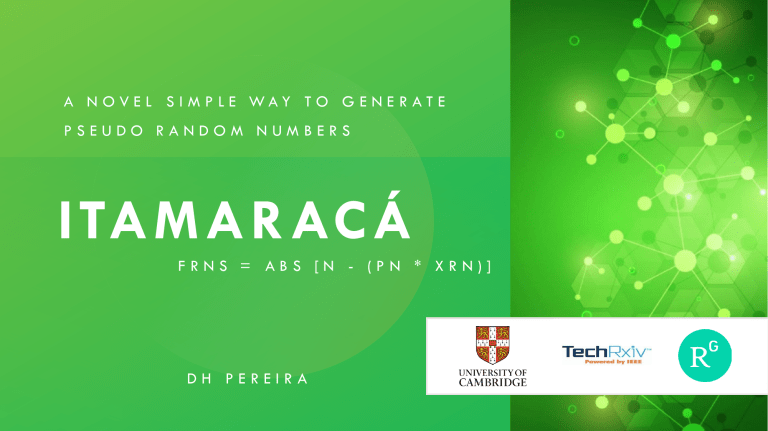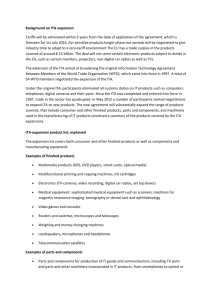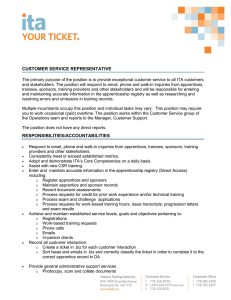Itamaracá: A Novel Pseudo-Random Number Generator
advertisement

A N OV E L S I M P L E WAY TO G E N E R AT E PSEUDO RANDOM NUMBERS I TA M A R AC Á FRNS = ABS [N - (PN * XRN)] DH PEREIRA U N D E R S TA N D I N G I TA M A R AC Á • Itamaracá or simply "Ita" is a novel, simple, fast and 'non-periodic' mathematical basis for PRNG that generates an "infinite" sequence of numbers within an interval [0,1] considering a uniform distribution. • Its name is derived by the Tupi-Guarani language in which means "Stone Shaker" or "Singing Stone", in this sense, a clear reference to something random or unexpected. H O W I TA W O R K S Like all PRNGs algorithms, Ita have some distinctive features. Below we have some initial conditions: • Firstly, choose N, that is, a maximum value within a range between 0 and N selected by a user criterion, where N ∈ ℕ. • In this model, there are 3 seeds S0, S1 and S2. For each of these seeds choose any number ∈ ℕ belonging to the interval between 0 and N (already choose previously). H O W I TA W O R K S After selected all the 3 seeds, S0, S1 and S2, the calculation process is divided in two main and very simple steps: • Pn (n Process) • Final Calculation H O W I TA W O R K S Pn (n Process) or Intermediate State In this stage we need taking into account the absolute values considering the differences between the 2 seeds that must be moving in the sequence. Pn = ABS (S2 – S0) H O W I TA W O R K S Final Calculation or General Formula In this step, we must multiply the “x” result obtained in the first step (in Pn) by the Xrn, that is, any value in which its founded value is desirable to be close to 2 (i.e. 1.97, 1.98, 1.99789...). FRNS = ABS [N – (Pn * Xrn)] A P P L I C AT I O N E X A M P L E Let's assume we want to generate numbers from 0 to 10,000: N 10,000 Seed 0 8,777 Seed 1 11 Seed 2 8 A P P L I C AT I O N E X A M P L E We can generate the first number using the intermediate state (Pn) and then using the main formula, as we can see below: P1 = ABS (8 – 8,777) = 8,769 FRNS1 = ABS [10,000 - (8,769*1.97) = 7,275 A P P L I C AT I O N E X A M P L E 2nd number: P2 = ABS (7,275 – 11) = 7,264 FRNS2 = ABS [10,000 - (7,264*1.97) = 4,310 3rd number: P3 = ABS (4,310 – 8) = 4,302 FRNS3 = ABS [10,000 - (4,302*1.97) = 1,525 A P P L I C AT I O N E X A M P L E So, we have the first three numbers generated: 7,275 - 4,310 and 1,525... The next sequences from now on follow the same calculation logic. RESULTS OF SOME TOOLS AND S TAT I S T I C A L T E S T S Comparing the results between Ita and TRNG by Random Org considering 10,000 numbers generated Tests Ita Random Org Chi-Square 11.26 3.65 Repeated Numbers / N 3,618 3,763 4,941 / 2,884 4,925 / 2,905 Run Test (Even/Odd) -0.914634 0.004101 Run Test (Median) 0.759184 0.603023 Autocorrelation (Average of the first 10 k-lags different from 0) 0.000103 0.000980 Shannon Entropy 3.45327 3.45284 Average / Standard Deviation Note: Methodology used for evaluating the results are exactly the same as those contained in the published version. RESULTS OF SOME TOOLS AND S TAT I S T I C A L T E S T S Histogram for Ita model 1 19 37 55 73 91 109 127 145 163 181 199 217 235 253 271 289 307 325 343 361 379 397 415 433 451 469 487 505 523 541 559 577 595 613 631 649 667 685 703 721 739 757 775 793 811 829 847 865 883 901 919 937 955 973 991 RESULTS OF SOME TOOLS AND S TAT I S T I C A L T E S T S Run Sequence for Ita model Line Graph for 1,000 numbers generated by Itamaracá 12000 10000 8000 6000 4000 2000 0 RESULTS OF SOME TOOLS AND S TAT I S T I C A L T E S T S Scatter Plot for Ita model Scatter Plot for 1,000 numbers generated by Ita 12000 10000 8000 6000 4000 2000 0 0 200 400 600 Série1 800 1000 1200 S O M E C O N S I D E R AT I O N S • Ita model has proven to be a good random number generator, especially in the criteria that evaluate independence and uniformity. Despite being a recent study, there are good perspectives regarding the computational cost and its applicability for the cryptography area and becoming a CSPRNG. • Another point to be highlighted is that it was not observed any rule of choice regarding the value of the seeds, it is enough they are chosen arbitrarily with values are within the range from 0 to N where N ∈ ℕ, their maximum value. S O M E C O N S I D E R AT I O N S • Regardless of the initial seed values used, there is a strong tendency for the algorithm to pass basic statistical tests for uniformity and independence. However, although approved, some chosen values can cause the results of certain tests to be "better" or "worse" than when using other seeds. S O M E C O N S I D E R AT I O N S • Ita model as every PRNG also has some identified limitations. As an example, at some point probably after a large amount of generated numbers, the repetition of the same sequence of generated numbers only tends to repeat if and only if the values of the 3 initial seeds (S0, S1 and S2) appear in the middle of the generated sequence. • Despite this limitation, we can see it is very difficult for this sequence of numbers to be repeated itself completely, as we increase the value of N and considering an uniform distribution [0,1]. Well, we can infer it is a generator that generates "infinite" and 'non-periodic' psedourandom numbers. The generation of random numbers is too important for several fields of study and practical applications for the development of mankind. CONCLUSION The present study, presented a new and simple proposal of a Pseudo Random Number Generator (PRNG) called "Itamaracá" (Ita in a abbreviated form). Ita model, like all PRNG algorithms, has some limitations, but in general, it showed good results in the statistical tests considered, and thus, as one more model in the portfolio, it is fully available for use and above all, for new studies, especially those applied to a specific objective and real problems.




